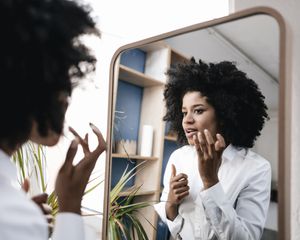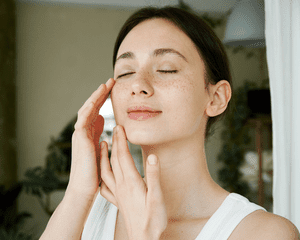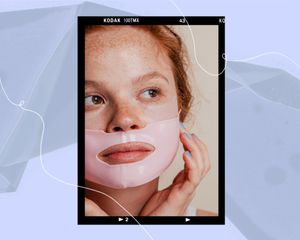:max_bytes(150000):strip_icc()/GettyImages-462602401-8ed9254736744cf4ade6202516afb10a.jpg)
Topalov / Getty Images
In This Article
Our skin is a wondrous thing, our body's largest organ. We spend an obscene amount of time obsessing, admiring, and lamenting over it—especially when it tends to act in a way we don’t understand (or agree with… Curse you, stubborn zit).
Case in point: keratosis pilaris. Two strange and slightly scary-sounding words that could explain why you’ve been getting those tiny, rough bumps in patches on your arms and legs. But how do you know for sure? To help you avoid getting sucked into an internet black hole, we chatted with celebrity esthetician Renee Rouleau and dermatologists Anna Guanche, MD, and Aimee Paik, MD, to school us on this common skin condition—including how to get rid of it for good.
Keep scrolling for the 411 on keratosis pilaris.
Meet the Expert
- Anna Guanche, MD, is a board-certified dermatologist and dermatologic surgeon based in Los Angeles.
- Aimee Paik, MD, is a board-certified dermatologist based in Salinas, California.
- Renee Rouleau is a celebrity esthetician with more than 30 years of industry experience.
What Is Keratosis Pilaris?
Keratosis pilaris is a skin condition that causes small bumps and rough patches on areas of your body, like your arms, thighs, cheeks, and more. It’s sometimes called “chicken skin,” which should give you a pretty good (if somewhat unpleasant) idea of what it looks like. “Keratosis pilaris occurs when dead skin cells and a protein in the skin, called keratin, build up and block the hair follicles,” Rouleau says. “These are tiny red or white bumps [that occur] in patches—it’s very common and completely harmless.”
Causes
Those of you who may have keratosis pilaris know that no matter how harmless it is, it’s still a pain to deal with. So why do some people have it while others can bare their smooth, bump-free arms? “Why some people will get it and others won’t is unknown,” Rouleau says. “However, genetics seem to play a role, especially for those with lighter, fair skin.” She says that in most cases, it usually appears during the first decade of your life but can start to disappear for most people in their mid-30s—good news.
Symptoms
Keratosis pilaris is often confused with a bunch of other skin conditions, so make sure you know what sets it apart. “If you’ve had it since your childhood, it doesn’t [constantly] itch, and is pretty consistent year-round, then it’s a strong indication that it’s this condition,” Rouleau says. Many other conditions can appear similar to keratosis pilaris, so often you'll need an evaluation by a dermatologist.
That's not to say KP won't change with the seasons. According to Guanche, the condition is known to get itchier and become more obvious in the winter months due to lower humidity levels and consequent drying of the skin.
What's more, it's also possible to get the bumps on your face. "Keratosis pilaris rubra is a geographic patch of redness on each cheek and is lovingly dubbed the Prince Harry disease," Guanche says, noting that it gets worse and can scar in individuals who insist on picking and scratching at the bumps without using topicals to treat the skin and soften the spines first.
Treatments
On to the question we’ve all been wondering: Is it treatable? According to our experts... yes and no.
Exfoliating
Rouleau says that doing certain things like exfoliating will help decrease its appearance but not necessarily get rid of it completely. Here’s her recommendation: “Combining physical exfoliants (like scrubs) and chemical exfoliants (think: acids) will soften and smooth away even the driest, roughest, bumpiest form of keratosis pilaris.”
She suggests squeezing a mild shower gel onto a loofah next time you shower, then scrubbing the affected area in circular motions for two minutes. After your shower, apply an exfoliating serum that contains a powerful percentage of glycolic acid—she recommends her eponymous line’s Pro Results Power Serum. Then, just follow with your favorite body lotion.
Byrdie Tip
Repeat this process every other day to try to keep bumps to a minimum and reveal smoother, softer skin with less redness.
Creams and Washes
Guanche notes that creams and washes containing urea, lactic acid, or glycolic acid are your best bet for reducing the appearance of KP.
Keep in mind, however, that products made with these ingredients should be used with care. "These moisturizers can be irritating, especially since individuals with KP tend to have sensitive skin, so they should be used on the affected sites only," says Paik, who is the medical director for Apostrophe, a direct-to-consumer dermatology company that connects people directly to board-certified dermatologists. They should also be used regularly: "They can be quite effective when used consistently, but the skin will revert back to its original state if they are stopped," she adds.
If you prefer a more streamlined approach to your KP treatment, Guanche says the Glytone KP Kit has you covered. "They have both a glycolic acid body wash and exfoliating body lotion which exfoliates dead surface skin cells, while soothing rough bumps and dry patches," she explains. She notes that body microdermabrasion, such as SilkPeel Dermalinfusion, is also effective for those who wish to be wedding-, vacation-, or prom-ready.
Home Remedies
If you prefer trying at-home treatments before heading to a derm, Guanche says that coconut oil, which has anti-inflammatory and moisturizing properties, can help soothe dry, itchy skin. "If added with sugar, this can also double as a gentle exfoliating scrub," she adds.
Then there's the benefit of focusing on your air quality. While it might seem extra, Guanche says it can play a big role in the appearance of your KP. "Humidifiers add moisture into the air which can prevent the skin from drying out and making KP worse," she explains.
What to Avoid
There are certain things in your skin routine that could be making your keratosis pilaris worse. Rouleau says to avoid any topical drying products, which may exacerbate the condition (discuss whether your current regimen could be worsening your condition with your dermatologist). Other things to avoid? Bar soap and foaming cleansers (all too drying, according to Rouleau). And whatever you do, don't physically exfoliate your skin without first applying a topical. "This will only lead to redder, more angry-looking, more noticeable spiny bumps," Guanche warns.
The Final Takeaway
Keratosis pilaris is a common, harmless skin condition with unknown causes. It may go away on its own as you age—Rouleau says during your 30s, to be exact. Until this happens, unfortunately, it’s unlikely anything you do will make it go away permanently. “If you’re consistent about exfoliation, however, it should improve considerably,” Rouleau exclaims.



